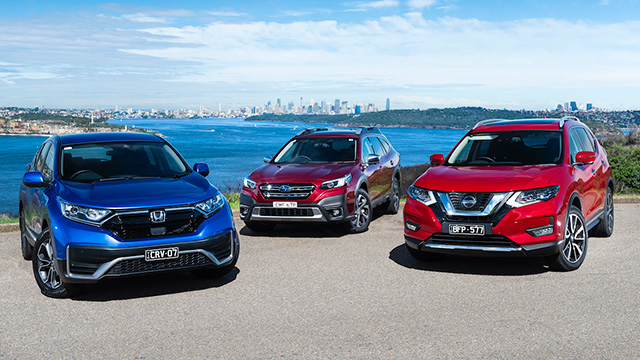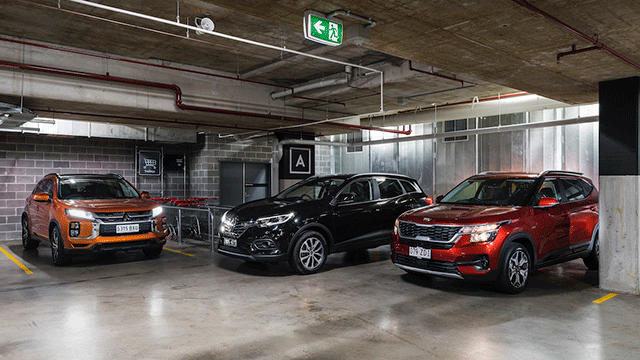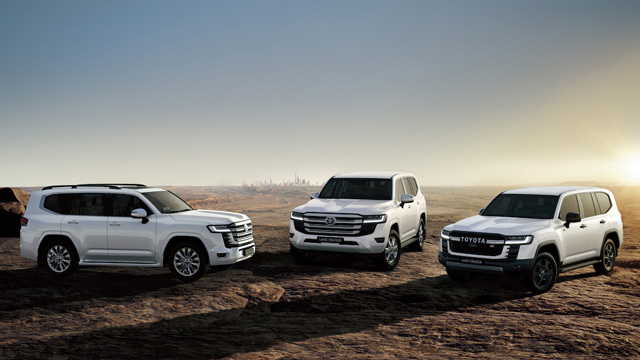By Kris Ashton for the Open Road Magazine
Photos by Anthony Warry
Toyota Corolla Cross vs Honda HR-V vs Kia Seltos comparison review
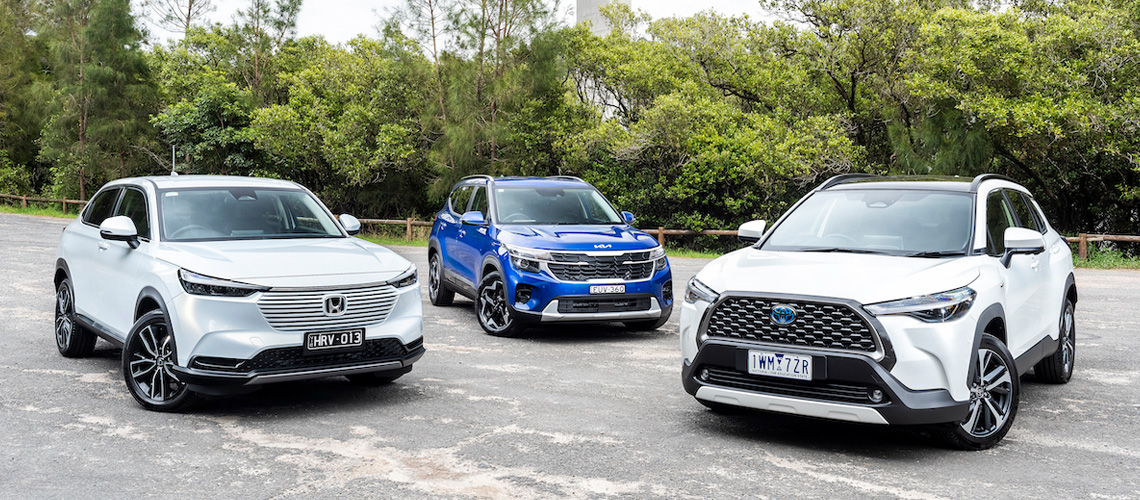
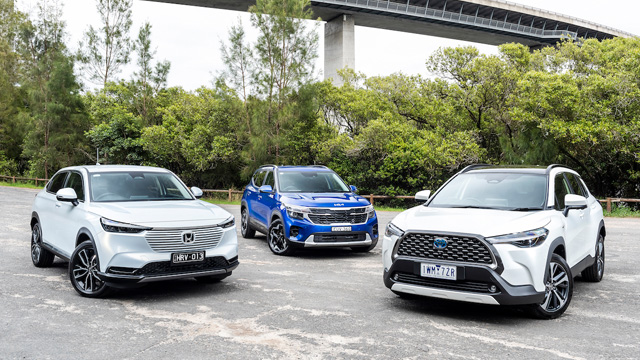
We put a small SUV newcomer, the Toyota Corolla Cross, up against the latest Honda HR-V and a freshly facelifted Kia Seltos
Toyota Corolla Cross Atmos 2023
When Akio Toyoda took over as president of Toyota in 2009, it led to a change in philosophy for the company, one which manifested in radical styling changes and several new models trickling into the mix. One of the latest is the Toyota Corolla Cross, which slots in above the well-received light SUV, the Yaris Cross.
With its angular plastic wheel arches and squarish silhouette, the Corolla Cross presents as a mini RAV4 – not a bad thing considering the current RAV4 has been the top-selling mid-sized SUV in Australia since its debut.
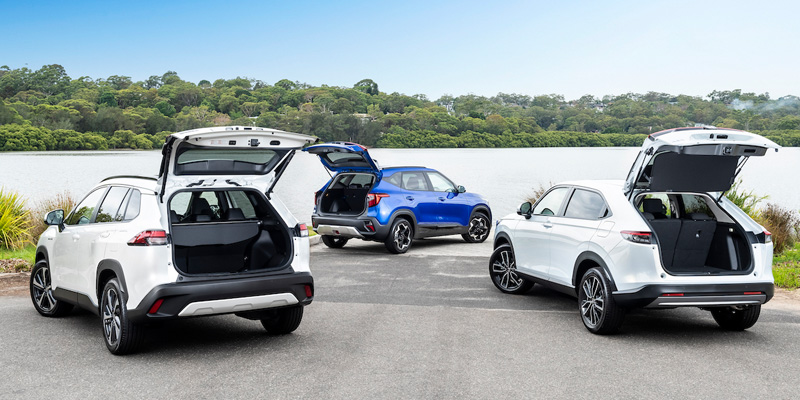
Toyota Corolla Cross Atmos 2023 range
The three-model Corolla Cross range consists of the GX ($33,000), GXL ($36,750) and Atmos ($43,550), with hybrid versions of the GXL and Atmos available in AWD.
Standard features on the GX include 17-inch alloy wheels, an electric parking brake, heated side mirrors, a seven-inch digital driver display, keyless entry and start, an eight-inch infotainment touchscreen, DAB+ radio, and Apple CarPlay/Android Auto connectivity.
It meets its modest price via fabric seats and a plastic steering wheel and gear shifter knob.
The GXL steps up to dual-zone air conditioning, better LED headlamps, rear privacy glass, sequential indicator lights, roof rails, a 10.5-inch infotainment screen with sat-nav, plus a leather steering wheel, shift knob and seats.
The Atmos enjoys 18-inch alloys, heated and electrically adjustable seats, rain-sensing wipers, a heated steering wheel, 12-inch driver display, and a panoramic moon roof. The hybrid 2WD Atmos (our test vehicle) costs $46,050.
Toyota Corolla Cross Atmos 2023 interior, tech and design
The Atmos interior is less utilitarian than the RAV4’s, with a surprising number of soft touch surfaces. The black and silver colour scheme and various styling elements are coherent if unremarkable.
Among the nice-to-have goodies in the Atmos Hybrid are an induction charger (located in a cubby-hole behind the gear shifter) and automatic on/off handbrake.
Climate and infotainment controls are generally well laid out, the only gripe being the tiny volume buttons below the screen, which can be tricky to use on a bumpy road. Nitpickers might also decry the basic single-size cup holders up front, but there’s little else to complain about.
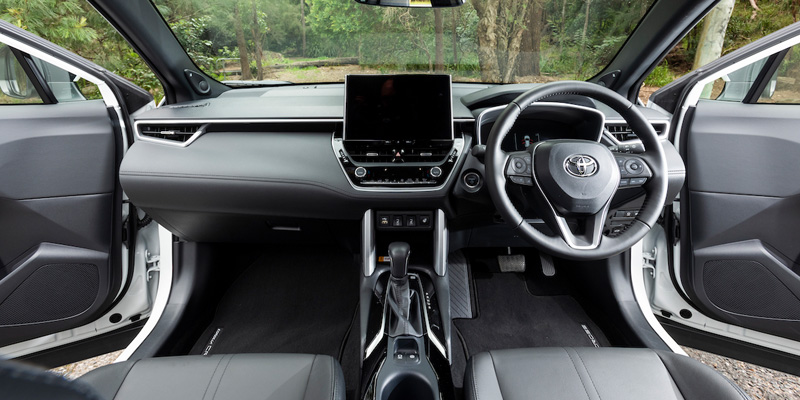
The seats are well bolstered and comfortable and Toyota has taken the interesting tack of forgoing USB connections up front, perhaps assuming the induction charger and Bluetooth connection make such ‘old tech’ obsolete.
There are two USB-C ports in the rear, however, along with a folding centre armrest replete with two cup holders. Another two cupholders are located high up on the rear doors, much more convenient than the traditional positioning just above the door sill.
Rear leg room isn’t tremendous and with the armrest down there isn’t a great deal of space for elbows, but head room is quite good and the tilt adjustable seats are comfortable enough. The centre seat is hard and narrow, though, and best left for kids or short journeys.
Toyota Corolla Cross Atmos performance and economy
Not only does the Corolla Cross look like the RAV4, it also offers similar performance. A 2.0-litre four-cylinder petrol engine (112kW/190Nm) works in tandem with an electric motor (83kW/206Nm) to deliver a combined 146kW and 190Nm. This ensures excellent throttle response, especially off the mark.
When asked to go up a long, steep hill the engine tends loiter at the screamy end of the rev range (again like the RAV4), but the vast majority of the time the Corolla Cross offers smooth and torquey acceleration and is a pleasure to drive.
It probably has the dullest steering of the three in this comparison, but evaluated in solitude there’s really nothing wrong with it.
Fuel consumption has been a key component of the RAV4 Hybrid’s success and the Corolla Cross hybrid is similarly frugal, returning a touch under 6.0L/100km on our test run – although that’s quite a way off Toyota’s claimed 4.3L/100km.
Honda HR-V Vi X 2023
When it debuted in 1998, the Honda HR-V looked like nothing else on the road and there’s an argument to say it was the prototypical small SUV. It lived a comparatively short life before Honda pulled the plug and the HR-V wouldn’t return to Australian roads until 2015.
That model has been selling steadily here ever since. While the third generation HR-V launched in Japan back in April 2021, it only reached Aussie shores for the first time in mid-2022.
Honda HR-V Vi X 2023 model range
Honda has kept the local model range to a bare minimum, with the base Vi X listing for about $35,000 (Honda only quotes the $36,700 drive away price) and the hybrid e:HEV L priced at roughly $45,500 ($47,000 drive away).
The Vi X runs a 1.5-litre petrol engine that puts out 89kW/145Nm, while the e:HEV L employs a hybridised version of the same engine for 96kW/253Nm.
Honda HR-V Vi X 2023 features (H3) Standard kit in the Vi X (our test car) includes 18-inch alloy wheels, keyless entry and start, automatic headlamps, an electric parking brake, and a nine-inch infotainment touchscreen with DAB+ radio and Apple CarPlay/Android Auto.
The extra $10,000 for the hybrid buys a leather steering wheel and leather-appointed upholstery, piano black finishes, active cornering lights, rain-sensing wipers, dual-zone climate control, and auto up/down on all windows.
Honda HR-V Vi X 2023 design
With a grille that looks like it belongs to an EV and the exterior’s smooth, minimalist lines, this HR-V is a big departure from the model it replaces and, if our vox pop is anything to go by, very much a love it or loathe it proposition.
The build quality is rock solid, as good or better than the Toyota’s, and everything from the door handles to the indicator stalk gives the impression it will outlast the car’s owner. However, while the HR-V is bolted together well, its interior presentation – especially in the Vi X – runs a distant third in this comparison.
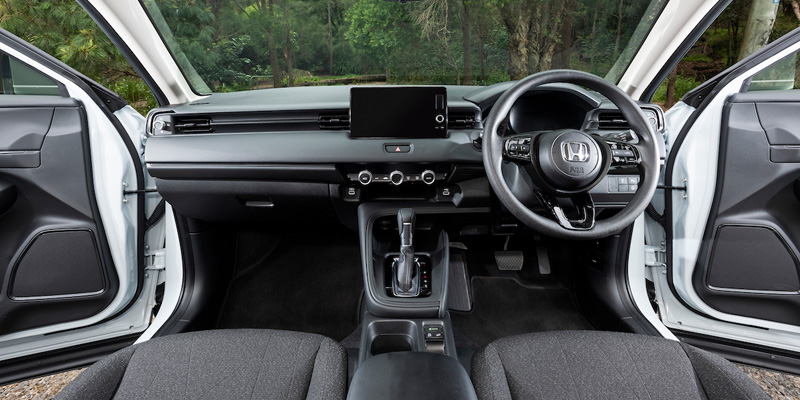
Between the grey plastics in the dashboard and the rather scratchy cloth on the seats, it feels like a throwback to the small SUVs of yore rather than a brand new model. With the second-row seats up, the HR-V’s cargo area is also the smallest by far.
The seats are roomy and well padded, though, and the interior-to-cargo-space ratio has a certain logic for those likely to freight adults rather than kids and a pram. Honda’s ‘magic seats’ also make the HR-V versatile in the items it can carry home from Bunnings or Flower Power.
Honda HR-V Vi X 2023 performance and economy
The naturally aspirated 1.5-litre four-cylinder engine and CVT combination in the Vi X is surprisingly capable and belies its decidedly 1980s power and torque figures. Although the powertrain lacks acceleration off the line, once it’s rolling it is refined and responsive and always seems to have some pep at the ready (albeit noisily) when it’s needed.
The HR-V’s steering is sharper and more linear than that in its rivals, too, while the chassis dynamics and suspension lead to better road feel and more assured cornering. These attributes do come at the expense of a firmer ride and the HR-V can be fidgety over hot-patched potholes and other road imperfections.
The Open Road (link) team exchanged some unbelieving glances upon comparing receipts at the end of the fuel cycle – the non-hybrid HR-V returned 5.6L/100km to pip the Corolla Cross as the most miserly of the three.
In fact, on highways Honda claims it uses only 0.2L/100km more than its hybrid sibling, demonstrating just how far engine economy has progressed in the past 10 years. And, like Toyota, Honda says its hybrid will achieve 4.3L/100km with more urban-focused driving.
Honda HR-V Vi X 2023 features and appeal
Look beyond the quality engineering, however, and the HR-V’s attractiveness begins to falter. Where the Kia Seltos has a full-sized spare wheel and all 2WD versions of the Toyota get a space saver, the HR-V has only an inflation kit.
Even more unfortunate is a failure to meet ANCAP’s increasingly stringent safety expectations, which has seen the HR-V slapped with a four-star rating.
And, because it would have had to retrofit a child seat anchor point to meet Australia’s parochial Design Rules, Honda has opted to remove the second-row centre seatbelt altogether, rendering the HR-V only a four-seater. That’s not the end of the world, but it certainly hobbles the HR-V’s family-car appeal.
Kia Seltos Sport+ 2023
Kia Australia had high hopes for the Seltos when it launched here back in October 2019 and it didn’t disappoint, elbowing its way in amongst the frontrunners from the get-go. Even amid a slew of newcomers in one of the busiest market segments, the Seltos has continued to sell well.
One shouldn’t discount the role Kia’s design language has played in its success and, for 2023, the Seltos has been treated to a minor facelift. Its external proportions continue to please the eye, despite the grille area being a little busy. Inside, an infotainment screen that arcs across two-thirds of the dashboard is sure to impress.
Kia Seltos Sport+ 2023 range
Unfortunately, the Seltos has also been treated to a price hike of more than $2000 across the range. It comes in four specs – S, Sport, Sport+ and GT-Line – with a 2.0-litre naturally aspirated engine standard or a 1.6-litre turbo engine available for about $3000 extra on the Sport+ and GT-Line models.
The base model S now costs approximately $30,000 (Kia also only quotes the $31,690 drive away price), while the range-topping AWD GT-Line lists for about $46,000 before on roads. Our Sport+ test vehicle has the 1.6-litre turbo engine and optional AWD for $41,990 drive away.
Kia Seltos Sport+ 2023 performance and economy
In many respects Kia has become the breakfast cereal brand of cars – it delivers what is expected of it and does so to a predictable quality standard. That’s certainly the case with the Seltos.
It’s roomy everywhere, something particularly noticeable in the leg and foot space available to second-row passengers (even if the seats are a little firmer and less comfortable than those in the Honda).
Its 1.6-litre turbo engine has been tweaked to produce 146kW (up 16kW) and 265Nm and is now mated to an eight-speed transmission, the extra cog presumably designed to improve fuel economy.
In regular driving mode the Seltos can be reluctant to kick down unless really provoked, leaving it unresponsive in certain situations, but flicking it into sport mode solves this problem.
In any case, one can’t afford to be too precious about fuel consumption because the Seltos came last in our real-world testing, returning 7.6L/100km – a figure mid-sized SUVs are now achieving or bettering.
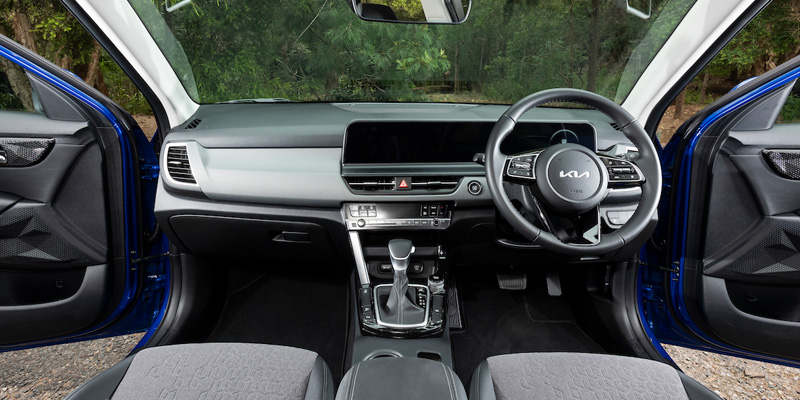
Kia Seltos Sport+ 2023 features and driving experience
Local Kia engineers have given the suspension a once-over for Australian conditions and the Seltos exhibits the balance between road feel and ride comfort that’s become a Kia hallmark.
Along with its parent company Hyundai, however, Kia is fast earning itself a reputation for the less commendable trait of overly intrusive safety systems.
In the past, Open Road has criticised the Hyundai Group’s nervous nelly lane keeping assistance. The Seltos is burdened with that and something even worse: should the driver happen to stray even 1km/h over the speed limit, he or she will be assailed with a volley of deafening bongs.
Now, we’re always in favour of responsible driver behaviour, but if a carmaker is going to design a speed alert this loud and annoying it had better ensure the underlying speed sign recognition system is near infallible – and the Seltos’ is far from it.
It frequently misses signs, leading to an unrelenting series of bongs even though the driver is obeying the speed limit, and it doesn’t account for school zone operating times, resulting in yet more unwarranted scolding every time the car passes through one outside school hours.
The alerts can be turned off – if you dig four steps deep into the infotainment menu – but they come back on every time you switch off the car. (The digital speedo also disappears each time, adding yet another technological irritant, although at least that can be retrieved with a couple of button presses on the steering wheel.)
The net result is the ruination of an otherwise pleasing all-round driving experience. The Corolla Cross achieved a five-star ANCAP safety rating without sending the driver round the twist, so why couldn’t the Seltos?
Final thoughts: which 2023 SUV wins?
The Honda HR-V is worth considering if crisp handling and fuel economy are paramount concerns, but the oversimplified model range and four-seat configuration have left it at a disadvantage here.
The updated Kia Seltos continues the carmaker’s recent history of well sorted and good-looking cars and the full-sized spare wheel is a real plus, but its irksome safety systems and comparative thirst knock it down peg or two.
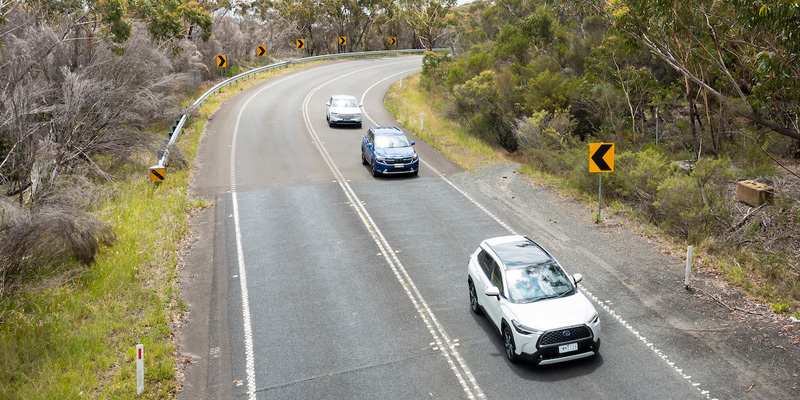
Aside from an engine that can be less than mellifluous under duress, the Toyota Corolla Cross exhibits very few foibles or shortcomings and, as it provides better overall performance than the HR-V while delivering similar fuel economy, it’s the clear winner in this contest.
Looking to buy a car?
Get a car loan from the experts in motoring for over 100 years, with a 1% discount for My NRMA members.







